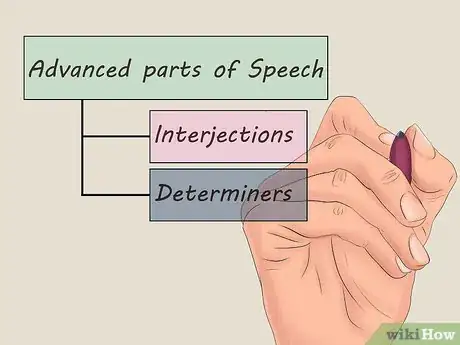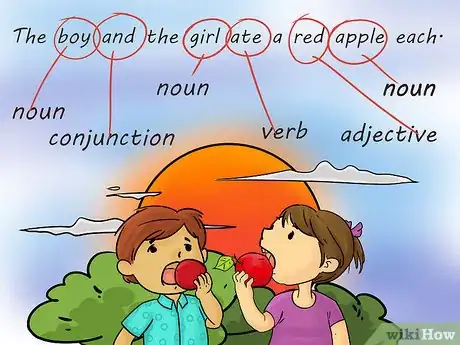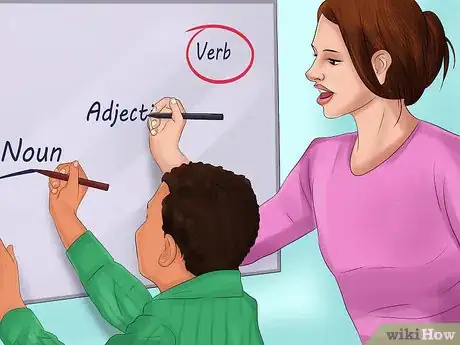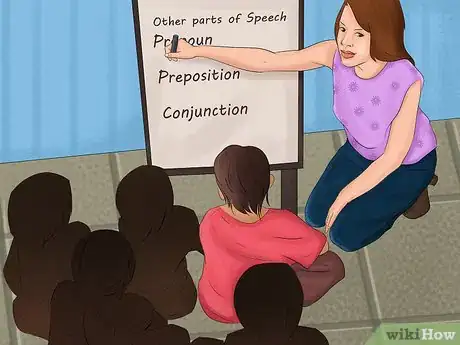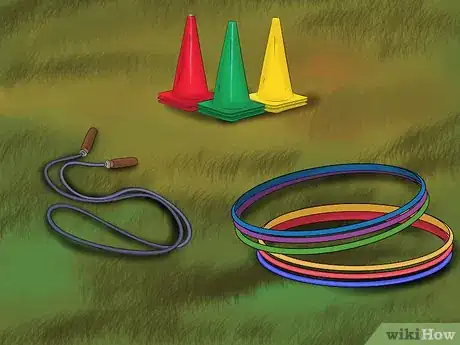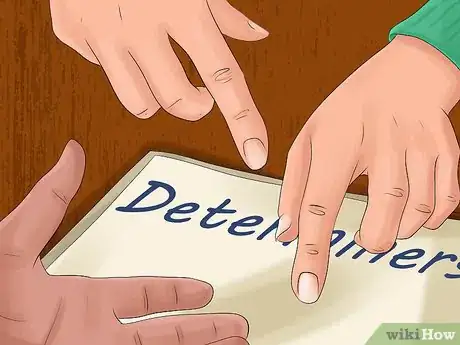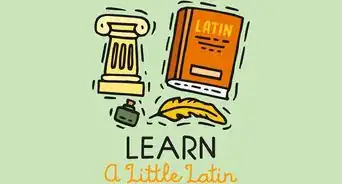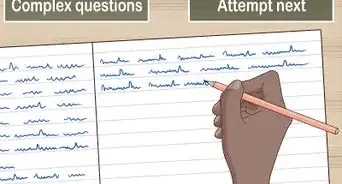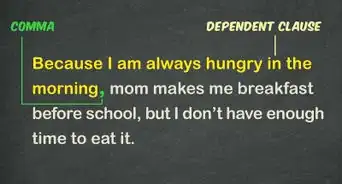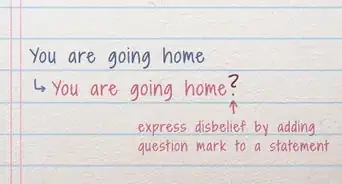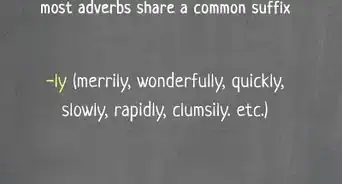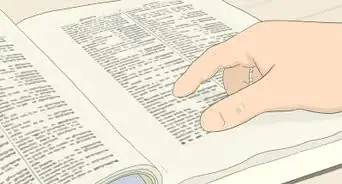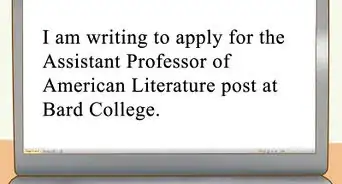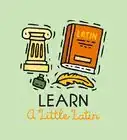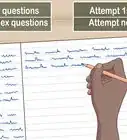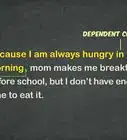This article was co-authored by Michelle Golden, PhD. Michelle Golden is an English teacher in Athens, Georgia. She received her MA in Language Arts Teacher Education in 2008 and received her PhD in English from Georgia State University in 2015.
There are 12 references cited in this article, which can be found at the bottom of the page.
wikiHow marks an article as reader-approved once it receives enough positive feedback. In this case, 88% of readers who voted found the article helpful, earning it our reader-approved status.
This article has been viewed 94,996 times.
It is one thing to know grammar; it is another thing entirely to teach it! When it comes to the parts of speech, you may have difficulty explaining their function and purpose within the sentence. That said, the parts of speech are essential units of the English language. There are nine different parts: nouns, verbs, adjectives, adverbs, pronouns, prepositions, interjections, conjunctions, and determiners.[1] If you are teaching or explaining these parts of speech, you can use a few tricks to help you demonstrate their linguistic use.
Steps
Identifying Parts of Speech
-
1Start with the basic parts of speech. Before you can explain to others what the parts of speech are, it is good to brush up on them yourself. Knowing the parts of speech can help clarify grammar lessons, increase understanding from students, and improve your own writing.[2] It is best to start with the four basic parts of speech. These are the nouns, verbs, adjectives, and adverbs.
- Noun: a person, place, thing, or idea. A noun can be common (a general object) or proper (the name of a person or place). For example, dog and goodness are common nouns while Rhode Island and Joe are proper nouns.
- Verb: a word that shows action or state of being. For example, run, jump, sit, learn are actions that a subject can do.
- Adjective: a word that describes a noun or a pronoun. For example, pretty, large, beautiful, and loud are all adjectives.
- Adverb: a word that describes a verb, an adjective, or another adverb. Adverbs usually end in -ly, but not always. For example, quickly and carefully are adverbs that modify verbs while very is an adverb that modifies adjectives and other adverbs.
-
2Introduce other parts of speech gradually. As your lessons develop, you can start introducing the more complex parts of the speech. Pronouns, prepositions, and conjunctions are a good intermediate step, as they have a clear function in the sentence and they interact with the basic parts of speech.
- Pronoun: a word that takes the place of a noun. The most common type are person pronouns. Personal pronouns include: I, me, you, we, he, she, it, and they. There are many different kinds of pronouns besides the personal. They include indefinite, interrogative, reflexive, intensive, relative, and others.
- Preposition: a word that describes the position of an object. For example, in, on, under, over, beside are all prepositions. A preposition begins a prepositional phrase.
- Conjunctions: words that join words, phrases, or clauses. The most common are the coordinating conjunctions (and, or, but, nor, for, yet, and therefore) and subordinating conjunctions, which are those words that join dependent clauses to main clauses in complex sentences (since, when, where, if, although, etc.).
Advertisement -
3Master the most advanced parts of speech last. Interjections and determiners can be difficult to teach and to learn because their function in the sentence is often ambiguous. Without a strong basis in the other parts of speech, learners might struggle with identifying these parts, and you might find it difficult to explain them. Save your lessons on these parts for last.
- Interjections: words that are used to express an emotion like surprise or shock or disappointment. They are words that are thrust into the midst of the sentence (hence, interjected).
- Determiners: the first words in noun phrases that act in a way that limits or quantifies the noun. Articles such as “a/an” and “the” as well as words like many, some, or two are what “determines” if the noun is specific or general.[3]
-
4Underline parts of speech. With eight differently colored pens or markers, underline, circle, or box every part of speech. Tell your students which color marker corresponds to which part of speech. For the rest of the lesson, whenever you underline that part of speech, use the same color. Once you are finished teaching the lesson, give your students a short passage to read. Ask them to underline each part of speech using the same corresponding colors as you did.[4]
-
5Ask questions. For nouns, verbs, adjectives, and adverbs, you can encourage students to ask certain questions to help them understand what the different parts of speech are. These questions will encourage them to think about how each part functions in the sentence as well as give them an easy tool for identifying the parts of speech.
-
6Make a chart. For the more difficult parts of speech—such as pronouns, conjunctions, interjections, and conjunctions—it may be easier to make a chart of the most common examples of these parts of speech. Explain these parts of speech, pointing to these examples on the chart. After the student has learned them, try asking them to make their own chart from memory.
-
7Diagram sentences. Diagramming sentences is a traditional method of explaining the parts of speech. In a sentence diagram, the parts are visualized on a series of connecting lines to show how the parts of speech relate to one another.
- On a horizontal line, write the noun subject and verb of the sentence. Divide these with a vertical line.
- Using diagonal lines, connect adjectives and determiners to the noun that they modify and adverbs to the verb or adjective that they modify.
- Use dotted lines to link conjunctions with the words that they connect.
Teaching Parts of Speech to Young Children
-
1Start basic. Work with children first on the four basic parts of speech: nouns, verbs, adjectives, and adverbs. For young children, these will be the concepts that are easiest to grasp. Conjunctions, interjections, determiners, and prepositions are more abstract concepts and therefore difficult for young children.
-
2Make a game. Children learn best when they are engaged in an activity. When it comes to grammar and the parts of speech, try making their learning a game. Set out eight paper bags, each labeled with a part of speech. With the child, write down a variety of words on a set of notecards. Ask them to place each word in its correct speech bag. For every word they correctly place, they earn a point.[8]
-
3Introduce tactile activities. Rather than present grammar as an abstract concept, try using activities that link the parts of speech to objects and actions that the child would use. One such activity can be done with a class or individual child. Write “Noun,” “Adjective” and “Verb” on the board or on a piece of paper. Place an object in a bag. Have a child reach into the bag and--without looking-- feel the object. Ask them what they think it is and write their answer under noun. Ask them what it feels like and write the answer under adjective. Ask them what they would do with it and write their answer under verb. Once you have all of their answers, have them make a sentence using all three of their words.[9]
-
4Sing a song. Music helps increase attention and improve memory when learning. Children may find it easier to memorize tricky grammar concepts when it is explained to them in song. There are songs available on the internet or available on children’s music albums. Better yet, try to write a song with your class or child that will engage them in the creation process.
- Songs can provide an easier method for children to memorize the more difficult and abstract parts of speech, such as the conjunctions, interjections, prepositions, and determiners.
-
5Play Mad Libs. Mad Libs is a game where one person asks the other for various parts of speech, before inserting these words into a predesigned story template. What emerges is a funny and nonsensical story. Since Mad Libs requires players to understand parts of speech, you will be testing the child's understanding of grammar. They will be so tickled by the resulting story that they will not notice that you are teaching them.
-
6Create an obstacle course. This is a fun idea for a large group of children. Gather various outdoor sports equipment (such as hula hoops, cones, jump rope, and balls). Break up the children into groups. Each group must design an obstacle course using sentences that use all of the basic parts of speech: nouns, adjectives, verbs, and adverbs. They will describe the obstacle course to the other groups using their sentence, and the other groups must set up and perform the described action. Examples of sentences include:
- Quickly twirl in the green hula hoop.
- Gently bounce the big ball.
- Gracefully jump through the spinning rope.
Explaining Parts of Speech to ESL Students
-
1Learn the parts of speech in your students’ native language. It has been shown that literacy skills in a language learner’s native tongue can improve English proficiency.[10] If you can learn what the parts of speech translate to in the native language of your student or class, you may find it easier to explain it to them. If they know the parts of speech in their own language, they will pick up on the parts of speech in English much more quickly.
- If you have a class composed of speakers from many languages, this may be difficult to do. Instead, try asking each student what they would call a verb, noun, etc. in their own language. Have them produce examples of each in their native language before translating them into English.
-
2Teach parts of speech with vocabulary. Research suggests that vocabulary acquisition is one of the most important parts of learning a language, and strong vocabulary skills can increase the speed at which a learner becomes fluent.[11] As you teach vocabulary, ask your students to mark down the part of the speech of the word on their flashcards or in their notes. When you test vocabulary, ask them to not only define the word but state its part of speech. Students will quickly connect the part of speech with English words.
-
3Do a worksheet. Homework can reinforce your lesson and help clarify a subject outside of the classroom. Worksheets can guide a learner through the process of discovering parts of speech in a way that encourages memorization and application. As you explain the parts of speech, walk the learner through the worksheet. They may struggle and ask you questions that were not included in the lesson. After the first few examples, see if they can complete the worksheet on their own.
-
4Spend more time on determiners. Determiners are some of the most difficult parts of speech for non-native speakers to grasp. These short words at the beginning of noun phrases are often forgotten completely. Spend at least one lesson on determiners and reinforce them throughout your lesson plan. You can break up the determiners into specific and general determiners.[12]
- The specific determiners are used when the listener knows the exact noun the speaker is referring to. For example, in the sentence “That woman was speaking,” the determiner “that” refers to a specific woman known to the speaker and listener. Specific determiners include the definite article (the), possessives (my, your, his, her, its; our, their, whose), demonstratives (this, that, these, those), and interrogative (which).
- The general determiners are used with general subjects and nouns which are unfamiliar to the listener. For example, in the sentence, “A woman was speaking,” the determiner “a” refers to an unknown woman. General determiners include the indefinite articles (a/an) and words like any, other, another, or what.
Community Q&A
-
QuestionWhat is the importance of parts of speech in the English language?
 Community AnswerParts of speech are the basic units of the language. By understanding parts of speech, you can tell what order your words should go in, how your word functions in the sentence, and how to look up the word in the dictionary. When you learn a new word in English, it is good to learn what part of speech it is so that you can use it correctly.
Community AnswerParts of speech are the basic units of the language. By understanding parts of speech, you can tell what order your words should go in, how your word functions in the sentence, and how to look up the word in the dictionary. When you learn a new word in English, it is good to learn what part of speech it is so that you can use it correctly. -
QuestionWhat is a prepositional phrase?
 Community AnswerA prepositional phrase is a group of words that begins with a preposition and ends with an object such as a noun, pronoun, or gerund. A preposition phrase will state the position or direction of a sentence. In the sentence, "They walked into the woods," the phrase "into the woods" is a prepositional phrase because it indicates where they are walking. "Into" is the preposition" and "woods" is the noun or object of the phrase.
Community AnswerA prepositional phrase is a group of words that begins with a preposition and ends with an object such as a noun, pronoun, or gerund. A preposition phrase will state the position or direction of a sentence. In the sentence, "They walked into the woods," the phrase "into the woods" is a prepositional phrase because it indicates where they are walking. "Into" is the preposition" and "woods" is the noun or object of the phrase. -
QuestionWhat is the object in a sentence?
 Community AnswerIt is easiest to understand objects in relation to subjects. Both subjects and objects are usually nouns. The subject of a sentence is the noun doing the action. The object of the sentence is the noun receiving the action. In other words, in the sentence "The girl is brushing her hair," "girl" is the subject, because she is doing the action of brushing, whereas "hair" is the object because it is is being brushed by the girl.
Community AnswerIt is easiest to understand objects in relation to subjects. Both subjects and objects are usually nouns. The subject of a sentence is the noun doing the action. The object of the sentence is the noun receiving the action. In other words, in the sentence "The girl is brushing her hair," "girl" is the subject, because she is doing the action of brushing, whereas "hair" is the object because it is is being brushed by the girl.
Warnings
- The above summary is just a scant view of the very complex aspect of the parts of speech.⧼thumbs_response⧽
References
- ↑ https://academicguides.waldenu.edu/writingcenter/grammar/partsofspeech
- ↑ https://www.butte.edu/departments/cas/tipsheets/grammar/parts_of_speech.html
- ↑ https://www.unr.edu/writing-speaking-center/student-resources/writing-speaking-resources/brief-guidelines-for-article-usage
- ↑ https://writing.colostate.edu/teaching/guide.cfm?guideid=115
- ↑ https://dictionary.cambridge.org/us/grammar/british-grammar/questions-interrogative-pronouns-what-who
- ↑ https://www.southeastern.edu/acad_research/programs/writing_center/handouts/pdf_handouts/adjectives.pdf
- ↑ https://www.butte.edu/departments/cas/tipsheets/grammar/adverbs.html
- ↑ http://www.education.com/activity/article/play_word_bags_third
- ↑ https://www.edutopia.org/article/make-parts-speech-engaging-have-students-do-teaching/


